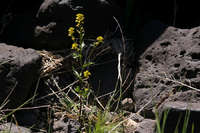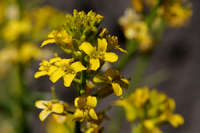Biennials or, rarely, perennials; glabrous throughout or margins ciliate. Stems (1.5-)2-9(-12) dm. Basal leaves: petiole (0.5-)2-10(-17) cm; blade lyrate-pinnatifid, (1-)2-8(-10) cm, lobes 1-3(-5) on each side (rarely early ones undivided), lateral lobes oblong or ovate, 0.3-2(-4) cm × 1-8(-15) mm, sometimes slightly fleshy, margins entire, repand, crenate, or dentate, terminal lobe (ovate or suborbicular), (0.7-)1.5-4.5(-7) cm × (4-)10-30(-50) mm, (surfaces glabrous or margins ciliate). Cauline leaves: blade ovate or suborbicular (undivided), margins usually coarsely dentate, rarely subentire; conspicuously auriculate, auricles ovate or narrowly oblong (to 10 × 5 mm), glabrous. Fruiting pedicels divaricate to ascending or erect, 3-7 mm, terete or subquadrangular, thickened (narrower than fruit). Flowers: sepals 3-4.5(-5) × 1-1.5 mm, lateral pair slightly saccate basally, margins scarious; petals yellow, spatulate or oblanceolate, (5-)6-9(-10) × 1.5-2.5(-3.5) mm, base attenuate, apex rounded; filaments 3-4.5 mm; anthers 0.7-1.2 mm; ovules 18-24(-28) per ovary; gynophore to 0.5 mm. Fruits erect to erect-ascending, rarely appressed to rachis, torulose, terete, somewhat compressed, or 4-angled, (0.7-)1.5-3 cm × 1.2-2 mm; style slender, (1-)1.5-3(-3.5) mm. Seeds dark brown, plump, broadly ovoid to oblong or subglobose, 1.2-1.5 × 1-1.2 mm. 2n = 16.
Flowering Apr-Jul. Waste places, ditches, riverbanks, damp grasslands, roadsides, fields, disturbed sites; 0-3000 m; introduced; Alta., B.C., Man., N.B., Nfld. and Labr., N.S., Ont., P.E.I., Que., Sask.; Ala., Alaska, Ark., Calif., Colo., Conn., Ga., Idaho, Ill., Ind., Iowa, Kans., Ky., Maine, Md., Mass., Mich., Minn., Mo., Mont., Nebr., N.H., N.J., N.Mex., N.Y., N.C., Ohio, Okla., Oreg., Pa., R.I., S.Dak., Tenn., Utah, Vt., Va., Wash., W.Va., Wis., Wyo.; Europe; Asia; n Africa.
Barbarea vulgaris, which is sometimes grown as a potherb, is highly variable in length and orientation of fruit and fruiting pedicel, style length, and the division of cauline leaves. Several varieties have been recognized, and they represent some of the many points along one continuum. In my opinion, it is better not to recognize any infraspecific taxa in North America.
Biennial or short-lived perennial herb 20 cm - 0.8 m tall
Stem: upright, branched above.
Flowers: in crowded, branched clusters, bright yellow, 6 - 8 mm long, 2 - 3 mm wide. Petals four. Stamens six.
Fruit: a narrow pod, ascending or spreading, 1.5 - 4 cm long, rounded in cross-section, curved, with a 2 - 3 mm long beak. Attached to a 3 - 6 mm long, 0.5 mm wide stalk. Seeds in one row.
Basal leaves: stalked, dark green, 5 - 12.5 cm long, with one to four pairs of small lobes and a large terminal one. Lateral lobes elliptic to egg-shaped. Terminal lobe egg-shaped to rounded.
Stem leaves: alternate, stalkless, somewhat clasping the stem, dark green, 5 - 12.5 cm long (progressively reducing in size), pinnately lobed to toothed.
Similar species: The variety vulgaris is very similar but its pods are strongly appressed to the stem. Barbarea verna differs by having four to ten pairs of lobes on its basal leaves and longer pods (4.5 - 7 cm).
Flowering: mid-April to mid-July
Habitat and ecology: Introduced from Europe. An abundant weed growing in a variety of habitats, such as moist fields, roadsides, and waste places.
Occurence in the Chicago region: non-native
Notes: This weed of the spring season is often mistaken for a Brassica, which blooms later.
Etymology: Barbarea refers to St. Barbara, a patron saint of artillerymen and miners. Vulgaris means common.
Author: The Morton Arboretum
As treated here this species includes Barbarea stricta Andrz. of Gray, Man., ed. 7 and of Britton and Brown, Illus. Flora, ed. 2, not Andrz.; also Barbarea vulgaris var. longisiliquosa Carion (Rhodora 11: 139. 1909). It is extremely variable in its leaves and in the position of the mature pods; however, the latest studies indicate that these differences are ecological (Jour. Bot. 54: 202. 1916 and 57: 304. 1919). This species is well distributed throughout the state and in some fields it forms colonies over large areas and is regarded as an obnoxious weed. It is found in fallow and cultivated fields, pastures, open woodland, and clover fields and along roadsides and railroads.
Duration: Biennial
Nativity: Non-Native
Lifeform: Forb/Herb
General: Herbaceous perennials to biennials, 20 cm tall or more, stems angled, erect, herbage glabrous throughout or margins ciliate, plants with pungent, watery sap.
Leaves: Alternate, basal and cauline; basal blades lyrate-pinnatifid, 1-10 cm long, with 1-5 lobes on each side, lateral lobes oblong or ovate, 0.5-4 cm long and 1-15 mm wide, sometimes slightly fleshy, margins entire, repand, crenate, or dentate, terminal lobes ovate or suborbicular, 0.5-7 cm long and 0.5-5 cm wide, surfaces glabrous or margins ciliate, basal leaves in a basal rosette or borne on petioles 0.5-17 cm long, cauline blades ovate or suborbicular and sometimes undivided, bases generally lobed, margins usually coarsely dentate or rarely subentire, blades conspicuously clasping the stem and auriculate, with ovate or narrowly oblong auricles, these to 10 mm long and 5 mm wide with glabrous surfaces.
Flowers: Yellow, with 4 petals creating a cross, petals sometimes recurved, spatulate or oblanceolate, 5-10 mm long and 1.5-3.5 mm wide, bases attenuate, apices rounded, sepals 3-5 mm long and 1-1.5 mm wide, lateral pair with a slightly rounded sac basally (saccate),with thin, membranous margins (scarious), filaments 3-4.5 mm, anthers 0.7-1.2 mm long, ovules 18-24(-28) per ovary, gynophore to 0.5 mm, flowers borne at stem tips in in pyramidal groups of, fruiting pedicels divaricate to ascending or erect, 3-7 mm, terete or subquadrangular, thickened (narrower than fruit).
Fruits: Linear, unsegmented siliques, cylindrical and tapering at both ends (terete), somewhat compressed or 4-angled, 0.5-3 cm long and 1-2 mm wide, erect to erect-ascending or rarely appressed to rachis, the pods often twisting (torulose), with strongly 1-veine
Ecology: Introduced, found in waste places, ditches, riverbanks, damp grasslands, roadsides, fields, and disturbed sites, from 0-10,000 ft (0-3048 m); flowering April-July.
Distribution: Widespread across much of the United States. Not found in Nevada, Texas, Arizona, Louisiana, or Mississippi.
Notes: A good stand-out identifier for this mustard is the exserted styles as well as the stamens, along with the 4-lobed yellow flowers with fairly wide petals, (for the family) and thin, bright green leaves. The name Barbarea vulgaris recently replaced the old name, Erysimum barbarea. This species is not known to occur in Arizona, Texas, or Nevada.
Ethnobotany: Infusion of leaves taken every half hour for coughs, and cooked salad eaten to purify blood, plant boiled, fried and eaten, and leaves parboiled, rinsed, seasoned with grease and salt and cooked until tender as potherbs.
Etymology: Barbarea is named after St. Barbara and once generally known as her herb, or the Herba Sanctae Barbarae. According to legend, St. Barbara was beheaded by her own father, a wealthy heathen named Dioscorus, for expressing a belief in Christ, and vulgaris means common.
Synonyms: Numerous, see Tropicos
Editor: LCrumbacher2012
Dark green, erect, branched above, 2-8 dm, bitter; basal lvs petiolate, with 1-4 pairs of small, elliptic to ovate lateral lobes and a large, ovate to rotund terminal one; cauline lvs progressively reduced, the upper sessile and generally lobed rather than pinnatifid, or the uppermost entire or merely toothed; fls crowded at anthesis; pet 6-8 mm; mature pedicels 3-6 נ0.5 mm; frs erect and appressed to ascending or spreading, 1.5-3 cm, the beak 2-3 mm; 2n=16. Native of Eurasia, now widely naturalized as a weed in wet meadows and in damp soil of fields, roadsides, and gardens. Apr.-June. (B. barbarea; Campe b.; B. stricta; Campe s.)
Gleason, Henry A. & Cronquist, Arthur J. 1991. Manual of vascular plants of northeastern United States and adjacent Canada. lxxv + 910 pp.
©The New York Botanical Garden. All rights reserved. Used by permission.









